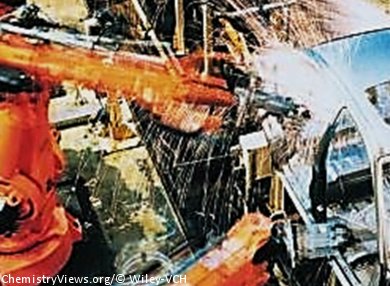Carbon fibers, the stuff of air buses, fast cars, and state-of-the art tennis racquets have been marketed since 1960. However, their broad commercial impact is hindered by their cost. Furthermore, to reap the benefits associated with the facile molding and assembly of carbon fibers direct on industrial assembly lines, the curing time and thermal latency of the carbon fiber polymerization process is key.
Michael Buchmeiser, University of Stuttgart, and Institute of Textile Chemistry and Chemical Fibers, Denkendorf, both Germany, and co-workers have innovated methods that use thermally latent catalysts for polymer synthesis. After applying Grubbs–Hoveyda-type ruthenium alkylidenes to ring-closing metathesis in both the liquid–liquid phase and the monolith-supported ionic liquid phase (SILP) [1], the group used them in ring-opening metathesis polymerization under homogeneous and biphasic (ionic liquid–organic solvent) conditions[2].
Here, a chain transfer agent facilitated the cleavage of the catalyst from the growing polymer chain, followed by separation of the polymer into the nonpolar phase and efficient catalyst reloading to the ionic liquid phase. The use of the chain transfer agent resulted in unprecedentedly low ruthenium content in the polymer product of 8–80 ppm, thus 98–99.8 % Ru was removed without further purification steps.
Such thermally latent catalysts have excellent prospects in carbon fiber technology, once the price is right. The minimal metal contamination they offer is also a step towards metal-free polymers for use in advanced biomaterials.
- Ionic Grubbs–Hoveyda Complexes for Biphasic Ring-Opening Metathesis Polymerization in Ionic Liquids: Access to Low Metal Content Polymers,
Camila P. Ferraz, Benjamin Autenrieth, Wolfgang Frey, Michael R. Buchmeiser,
ChemCatChem 2013.
DOI: 10.1002/cctc.201300751
References
[1] Ionically Tagged Ru–Alkylidenes for Metathesis Reactions under Biphasic Liquid–Liquid Conditions,
Benjamin Autenrieth, Felix Willig, Dominik Pursley, Stefan Naumann, Michael R. Buchmeiser,
ChemCatChem 2013, 5, 3033–3040.
DOI: 10.1002/cctc.201300199
[2] Ionic Grubbs–Hoveyda Complexes for Biphasic Ring-Opening Metathesis Polymerization in Ionic Liquids: Access to Low Metal Content Polymers,
Camila P. Ferraz, Benjamin Autenrieth, Wolfgang Frey, Michael R. Buchmeiser,
ChemCatChem 2013.
DOI: 10.1002/cctc.201300751




